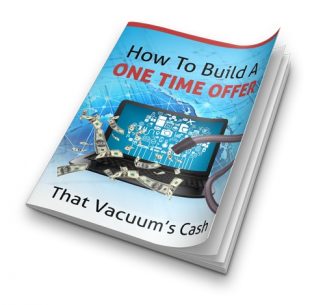 License Type: Master Resell Rights
License Type: Master Resell Rights  File Type: ZIP
File Type: ZIP
 SKU: 61707
SKU: 61707  Shipping: Online Download
Shipping: Online Download
Sample Content Preview
How to Build a One-Time Offer System That Vacuums Cash
What is a one-time offer (OTO)?
If you’ve ever downloaded a free report, booklet, book, video series or signed up to some sort of newsletter of email-based free course, you probably have ended up on a confirmation page. This page thanks you for signing up and it can give you some information regarding when you will receive the freebie that you are interested in.
If you lookedat the rest of the page, a lot the times you’re going to see an offer. This is called a one-time offer. This type of offer also appears when you bought an item, usually a low-priced product like an e-book, a report or software.
It’s important to note that regardless of how you get to this page, it only appears once. That’s the whole point of the one-time offer. It truly is a one-time offer. You get it when you are really “hot” or really interested in a particular topic or subject matter. Its scarcity is what makes it so powerful.
Why Offer an OTO?
Answer: psychology. When people sign up to your list or download a paid or free item, they’re obviously very interested in solving a set of problems the downloaded item or signed up newsletter addresses. They ended up on your squeeze page because they’re interested in a particular set of needs that they have. This is not theoretical. They’re not thinking about what their needs would be two months from now or a year from now. They’re actually involved with the issue now. They need a solution now.
In other words, when people get to your OTO, they are near or at the height of their greatest need for a solution to a specific problem. The OTO sells them a product or service that directly addresses or is closely related to the problem they are most interested in solving. How do you know they are “hot”? They trusted you enough to enter their name and email address to get on your list, buy your product, or download your software.
This is crucial. Somebody maybe interested in finding a solution to a problem but they may not be THAT interested, meaning, they are just kicking around the idea. They might even be leaning towards one particular solution instead of others but they can’t, for the life of themselves, commit. You’ve gone beyond that point because you had these people trust you enough to enter their email address and name. This shows you that they are serious about addressing the problem hey have.
When somebody is in this particular state of mind, they are less psychologically resisted to a sale. They feel that they are close to an answer or they have already arrived at the answer to their problems. The OTO simply seeks to capitalize on this extremely high interest level. You are in a stage of the sales cycle where you are in the “use it or lose it” stage of the sales cycle. It’s no surprise that a lot of OTOs either account for 40% of the sales of a funnel or leads to the vast majority of the sales made by an individual sales funnel.
How Does an OTO Work?
You have to getpeople to enter their email address and name. There are four common ways to do this. First, you can tell them that they would get certain information if they join your list. List members are promised a wide range of information involving a particular subject matter. This usually takes the form of an email-based course or a regular newsletter.
Alternatively, you can offer a free e-book, a booklet, or some sort of “ethical digital bribe” to get their email address. For them to sign up to your list, you give them a booklet or something that they are truly interested in. This free downloadable digital product directly addresses certain problems that they are interested in solving.
The third approach involves collecting emails after people bought a product. Usually, this takes place near the end of the sales cycles. They buy a product, they pay for it, and then they get redirected to a download page that collects emails by promising them some sort of a digital freebie or newsletter involving something closely related to the solution that they just bought.
Finally, you can collect emails by putting the email collection at the front of the sales process. Somebody goes through your site, they like what they see, they click to buy, and the first thing that greets themis not a payment form. This is not the form that they entered their PayPal email address in or credit card information. Instead, they see a simple form asking them for their name and email address. Little do they know that even if they abandon the sales process, they end up on your mailing list. Once they opt in, they then get redirected to the OTO page.
All the processes I described above lead to an OTO page. That’s how an OTO works. It’s still the same page and works the same way but getting there takes at least four different ways. Really creative marketers, I’m sure, have innovated additional approaches. However, the four common ways I described above should give you a place
to start. You can customize these. You can innovate on them. You can fit them to your particular set of circumstances.
Sounds good so far? Well, don’t get too excited. A lot of people build OTOs. In fact, it has become fairly routine and standard in the online marketing industry. As you can well imagine, when something becomes routine, people often drop the ball and they do.
Why Do Too Many OTOs Fail?
It really is quite tragic but the majority of OTOs simply fail to live up to their fullest potential. The OTO as a concept is a slam dunk if you know how to play it right. Imagine, you have all the pieces in place but you just dropped the ball at the last minute. All you needed to do was shoot the ball through the rim, but too many marketers fail to do that.
- License: Master Resell Rights
- Tags:2018 Ebooks Master Resale Rights








